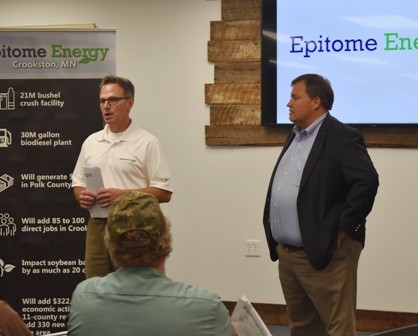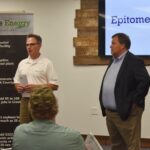Epitome Energy, LLC announced Thursday during an open house at Valley Technology Park that they were kicking off the air permitting and environmental assessment processes with the hopes of putting a shovel in the ground in the Fall of 2020. The open house was attended by more than 90 people including many local and state leaders. Among those attending were all of the councilmen from the City of Crookston, Department of Agriculture Commissioner Thom Peterson, State Representative Deb Kiel, State Senator Mark Johnson, Polk County Commissioners Gary Willhite and Joan Lee, and LeRoy Stumpf from U.S. Representative Collin Peterson’s office.
Dennis Egan, President, and CEO said Epitome was excited to be able to announce that they had hired their permitting and environmental assessment teams. “We were excited,” said Egan. “Boy, the turn out we had from the community, the growers, the City of Crookston. Every City Council member was here. We had our State Senator [Mark Johnson], and Representative Deb Kiel were here. We were excited and honored to make that announcement today that we have hired our permitting team and given them the green light to start the process.” Egan also announced that they are going to permit for 42 million bushels, doubling the original plan of 21 million bushels. If approved, it may come in different stages, but gives the option to double the crush portion of the facility in the future.
The permitting and environmental assessments will be coordinated by Minnesota based companies, Wenck Associates and Sunde Engineering, continuing a trend of Minnesota-based partnerships in developing the facility. “We are extremely excited to make this a Minnesota project,” said Egan. “So, whether it’s the permitting folks with Wenck [Associates] and Sunde Engineering, whether it’s our CPA firm with Christianson Associates out of Wilmar. To our announcement ten days ago or so ago that our technology provider is going to be Crown Technology, a world leader based in Minnesota. In the next ten days or so we’re going to announce our construction firm, and that’s another Minnesota company. To be able to look at a 42-million bushel a year crush facility, a 30-million-gallon biodiesel plant built in Minnesota, with Minnesota technology, a Minnesota construction firm, and Minnesota employees building it, we’re pretty excited that this the right place for the right project.”
Representatives from both Christianson Associates and Finishline Management, LLC, were also available during the open house to discuss equity investments. The goal for local equity investment is to raise up to $10 million, with minimum investments of $35,000.
Both Egan and Ag Commissioner Thom Peterson said there are a lot of challenges currently in the agricultural economy, but that the project can bring local benefits to the region. Egan said the more equity into the project that can be kept local, the more benefits there are to the community as a Minnesota based company. “The reality is we know the farm economy is tough,” said Egan. “And we have been very honest and open that we want to be able to raise part of that seed money, part of that $10 million locally. But we need to look at other opportunities with large equity players that might come in with a $20 million or $30 million equity play. But the more that we can keep local, and the benefits of this project local, that’s where we see the real gains being a Minnesota company.”
Peterson called Crookston a natural place to add value to the soybean crop and said he thinks that helping the basis will be great for the area. “Crookston is just such a natural place to get after adding value to the soybean crop and helping the farmer with their basis,” said Peterson. “So, I’m excited that the community, city, county, the farmers are moving forward with this project. I think it will be great for the area.”
Peterson also said the Department of Agriculture is working to make the process for agricultural projects more efficient. They will be having someone in their office coordinate working with various state agencies to get things accomplished quickly and accurately. “I think some of the frustration sometimes is that government is slow or is in the way,” said Peterson. “We want this to succeed. We want this done right. And so we’re going to work across the state agencies – whether it’s the DNR, MPCA, Department of Transportation, Department of Ag – to make sure that this project moves forward quickly and is done right.”
SOY INNOVATION CAMPUS
The Soy Innovation Campus, which will operate as a non-profit and has received $5 million in funding from the Department of Agriculture, was also a focal point of the open house. Tom Slunecka, the Executive Director/CEO for the Minnesota Soybean Research and Promotion Council and Minnesota Soybean Growers Association, said the campus would be the first of its kind.
Slunecka said that when prices are down, as they currently are, it’s time to think big about how to invest in adding value to farms and communities. “Whenever prices are down like this, we need to think big,” said Slunecka. “It’s typical that we think small when economics are hard. But now is the perfect time to think about what can we get done with the soybean and other grains that will add value not just to our farms, but to our communities. And that’s exactly what this campus is going to do. We’re going to prove out technologies from all across Minnesota that will create new jobs and better return on investments for the larger plants spread out across the state.”
The Soy Innovation Campus will partner with the University of Minnesota Crookston as it develops to test new and old technologies for use around the state. As well as provide processing training to people in and out of the Crookston Community said Slunecka. “This campus is going to be designed, so it has classrooms in it,” said Slunecka. “We’ll be introducing new technologies and old technologies for people to learn, train, and understand what processing is all about. There are all kinds of jobs processing facilities but whose training those folks? And if you’re going to get the best job possible you want to have some training. So, as the project develops, as the university gets more involved, as more and more technologies come into our facility, there will be more and more opportunities from people in and out of the Crookston community to come in and learn a new skill.
PERMITTING AND ENVIRONMENTAL ASSESSMENT
The air permitting and environmental assessment processes will take 10-12 months to complete. The process includes many analyses and working closely with the Minnesota Pollution Control Agency (MCPA) to meet state and federal standards said Lucas Taylor, Principal at Wenck Associates. “There are lots of analyses that we have to perform in partnering with the MPCA,” said Taylor. “So, preparing all the analysis and the permit applications. The environmental review process also has to be going parallel because permits can’t be issued until the environmental review process is done, and the MPCA’s review process [is complete] for the permitting. And it depends on the MPCA’s permitting queue, so, how many other construction applications they have in the queue that they need to process before this one.”
Crookston resident Bob Prudhomme asked what the odor from the facility would be as well as about the dust and noise that would be generated. Egan described the scent as similar to a cereal smell with a toasted soybean smell, also adding that Epitome is seeking not only to meet the state and federal standards for odor, noise, and dust but exceed them through the use of new technologies. Taylor said that dust, odor, and noise are all included in the permitting and assessment process, including a cumulative impacts assessment of all the dust and particulate matter generated by plants and facilities in Crookston. “The dust, odor, and noise is part of the environmental review,” said Taylor. “And then the air permitting would deal with the dust and the particulate matter. The environmental review process requires a cumulative impacts assessment. That’s part of the process that gets reviewed.”







